|

Its Not Easy Being Blue-green: The male (peacock) has beautiful iridescent blue-green or green colored plumage. The so-called "tail" of the peacock, also termed as the "train," is in fact not the true tail but the highly elongated upper tail coverts. The train feathers have a series of eyes that are best seen when the tail is fanned. Both species have a head crest.
Mousy Bird: The female (peahen) has a mixture of dull green, brown, and gray in her plumage. She lacks the long tail of the male but has a crest. Females can also display their plumage to ward off danger to her young or other female competition.
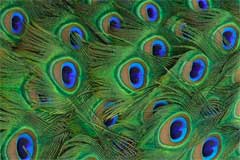 Optical Phenomenon: Many of the brilliant colors of the peacock plumage are due to an optical interference phenomenon (Bragg reflection) based on (nearly) periodic nanostructures found in the barbules (fiber-like components) of the feathers. Optical Phenomenon: Many of the brilliant colors of the peacock plumage are due to an optical interference phenomenon (Bragg reflection) based on (nearly) periodic nanostructures found in the barbules (fiber-like components) of the feathers.
Different colors correspond to different length scales of the periodic structures. For brown feathers, a mixture of red
and blue is required—one color is created by the periodic structure, while the other is a created by a Fabry-Perot interference peak from reflections off the outermost and innermost boundaries of the periodic structure.
Such interference-based structural color is especially important in producing the peacock's iridescent hues (which shimmer and change with viewing angle), since interference effects depend upon the angle of light, unlike chemical pigments.

Should I stay or Should I Go: Peafowl are considered to be polygamous. However in captivity, Green Peafowl and African Peafowl are monogamous, with males assisting in nest defense, chick rearing, and chick brooding. The male's bond with offspring may extend indefinitely. First-year chicks that have been weaned by their mothers generally join their father's social unit to forage and rest.
Complex Home Life: In Green Peafowl, it is impossible to distinguish juvenile and subadult green peafowls from their mothers and hence their polygynous nature is hard to establish. There is some anecdotal evidence suggesting that Green Peafowl may have very complex social lives that may include the adoption of one and two year old juveniles by their three and four year old sub-adult siblings.
Their Feathers Aren't Just for Show: Peafowl are unusual amongst the Galliformes in their capacity for sustained flight. All known genera of the peafowl family exhibit complex flight displays.
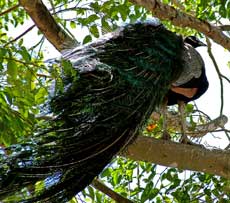 To Tree, or Not to Tree: The peafowl are forest birds that nest on the ground. The Pavo peafowl are terrestrial feeders but roost in trees. They are weak fliers. To Tree, or Not to Tree: The peafowl are forest birds that nest on the ground. The Pavo peafowl are terrestrial feeders but roost in trees. They are weak fliers.
The Secret Lives of Peafowl: Each race of the Green Peafowl has its own respective wing shape and flight display behavior. Green Peafowls in Java are often observed flying out to sea where the birds gather on islets some miles
from shore.
Wall of a Wing: African Peafowl have unusually large wings in relation to their weight. The wings have a highly unusual shape as well. The African Peafowl or Afropavo wing is prominently marked in both sexes in striking patterns and colors.
Piggy-back Bird: All known species of peafowl perch on emergent trees that stand above the canopy. Chicks of Indian Peafowl are sometimes carried on the backs of the parent birds as they fly into the security of a tree to roost.
-----------------------------------------------------------------------------------------------------------------------------
Three Times the Peafowl:
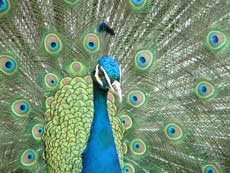 Indian Peafowl: The Indian Peafowl, Pavo cristatus, is a species of bird in the genus Pavo of the Phasianidae family. The Indian Peafowl is a resident breeder in India and Sri Lanka. Indian Peafowl: The Indian Peafowl, Pavo cristatus, is a species of bird in the genus Pavo of the Phasianidae family. The Indian Peafowl is a resident breeder in India and Sri Lanka.
Habitat: The species is found in dry semi-desert grasslands, scrub and deciduous forests. It forages and nests on the ground but roosts on top of trees. It eats mainly seeds, but also some insects, fruits and reptiles.
A Peacock's Plumage: The male is called a peacock, the female a peahen. The Indian Peacock has beautiful iridescent blue-green plumage. The upper tail coverts are enormously elongated and ornate with an eye at the end of each feather.
The female plumage is a mixture of dull green, grey and iridescent blue, with the greenish-grey predominating. In the breeding season, females can be told apart from the lack of the long tail feathers also known as the train. Peahens can be distinguished from males in the non-breeding season by the green color of the neck as opposed to the blue on the males.
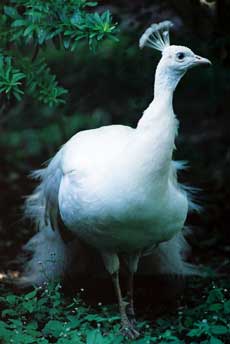 Train, not Tail: Peafowl are most notable for the male's extravagant tail also known as a train, a result of sexual selection, which it displays as part of courtship. This train is in reality not the tail but the enormously elongated upper tail coverts. The tail itself is brown and short as in the peahen. Train, not Tail: Peafowl are most notable for the male's extravagant tail also known as a train, a result of sexual selection, which it displays as part of courtship. This train is in reality not the tail but the enormously elongated upper tail coverts. The tail itself is brown and short as in the peahen.
It Takes a Village to Raise a Chick: They lay a clutch of 4-8 eggs which take 28 days to hatch. The eggs are light brown and are laid every other day usually in the afternoon. The male does not assist with the rearing, and can take up to six hens. This species can hybridize with the closely related Green Peafowl, Pavo muticus and create offspring called spauldings.
Decorative Peacocks: Peacocks are sometimes kept as domesticated animals for decoration. Many varieties exist, such as black-shouldered, oaten, white, purple, opal, pied, and midnight. The peacock is the national bird of India.
-----------------------------------------------------------------------------------------------------------------------------
Green Peafowl: The Green Peafowl, Pavo muticus is a large member of the pheasant family. Like others of the genus it is a colorful bird and is sometimes considered the most beautiful member of its family. The male Green Peafowl is up to 3 meters long, including the "train" and weighs up to 5kg. The female is 1,1 meter long and weighs up to 1,1kg.
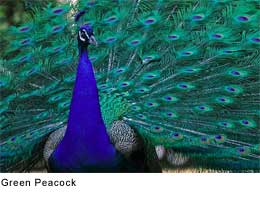 Tall Tail: One of the two species in the genus Pavo. The other being the Blue or Indian Peafowl, commonly known as the Peacock. Tall Tail: One of the two species in the genus Pavo. The other being the Blue or Indian Peafowl, commonly known as the Peacock.
The Green Peafowl has a green tufted crest, different in shape to the fanned crest of the Blue and an iridescent metallic green color plumage with scaly appearance on its neck, breast and mantle.
His emerald green tail feathers have a series of eyes that are best seen when fanned. The female plumage is mainly a dull grey-green and she lacks the long tail of the male.
Three Times the Green Peafowl: There are three subspecies of the Green Peafowl, Pavo muticus spicifer from northeastern India and northwestern Myanmar that now is believed to be extinct, Pavo muticus imperator found in Indo-China and the most brilliantly colored, nominate race Pavo muticus muticus of Java, Indonesia.
Green Peafowl in Danger: The Green Peafowl is evaluated as Vulnerable to extinction due to hunting and a reduction in extent and quality of habitat. It is listed on Appendix II of CITES.
-----------------------------------------------------------------------------------------------------------------------------
The Congo Peafowl: The Congo Peafowl, Afropavo congensis is the only member of the genus Afropavo. Male is large, up to 70cm long, deep blue with metallic green and violet tinge bird of the Phasianidae family.
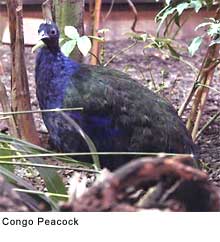 For Appearance's Sake: It has a bare For Appearance's Sake: It has a bare
red neck skin, grey feet, black tail of fourteen rectrices and adorned with vertical white elongated hair-like feathers on its crown. Female is generally chestnut brown bird with black abdomen, metallic green back and short chestnut brown crest.
Both sexes resemble immature Asian
Peafowl, with early stuffed birds being erroneously classified as such before they
were officially discovered as a species.
Just the Facts: The Congo Peafowl is endemic to lowland rainforests of Congo River Basin in central Democratic
Republic of the Congo. The diet consists mainly of fruits and invertebrates.
Mysterious Bird: Very little is known about this species, seeing as it was first recorded as a species in 1936 by Dr. James Chapin based on two stuffed specimens at Congo Museum in Belgium. It has characteristics of both the peafowl and the guinea fowl, which may indicate that the Congo Peafowl is a link between the two families.
Congo Peafowl in Danger: Due to ongoing habitat lost, small population and hunted in some areas, the Congo Peafowl is evaluated as vulnerable on the IUCN Red List of Threatened Species.

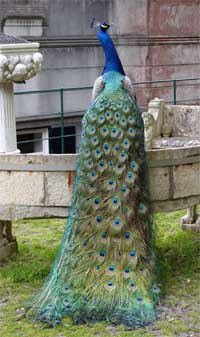 You Can't Hurry Love:
Peafowl are capable of reproducing at the age of 2. Peacocks You Can't Hurry Love:
Peafowl are capable of reproducing at the age of 2. Peacocks
do not reach full maturity until one year later.
At the age of 2, the feathers are not fully developed in length and density. While peacocks at that age are physiologically able to mate with peahens, they have very little chance of competing with older peacocks with larger feathers. At the age of 3, peacocks' feathers reach maximum length for their lives, aside from the new feathers that grow after they molt in the late summer.
You've Got to Impress the Ladies: Mating season starts in the early spring and ends
in the early autumn. The peacock's courtship rituals include the display of its startling plumage and a loud call.
Recent studies have shown that both the frequency and quality of sexual plumage displays by males are reliable indicators of
the health status of an individual.

Just the Facts: The typical Asiatic peafowl belonging to the genus Pavo includes the familiar Indian Peafowl (Pavo cristatus) and the much rare Dragon birds or Green Peafowl (Pavo muticus). The Congo Peafowl is found in parts of Central Africa.
Peacock Culture and Mythology: The Indian Peafowl is the national bird of Burma and India. In Hindu mythology it is mentioned in stories associated with Krishna, as well as with those of Murugan, son of Shiva.

Classification Confusion: Some taxonomists believe that the endangered Green Peafowl is actually a complex of five distinct species although they are currently treated as one species with three subspecies. The Javanese Green Peafowl, Pavo muticus javanensis is an endemic found on the island of Java. The extinct Malay or Pahang Peafowl Pavo muticus muticus was earlier thought to be introduced by humans from Java, but fossils from the Pliocene epoch rules this out. Northern Yunnan is the home of one of the most distinctive form of Green Peafowl, The Yunnan Dragon birdPavo muticus yunnanensis. The Arakan Dragon birdPavo muticus spicifer was once native to Northern Western Myanmar, Southern Tibet and Assam. The Indo-Chinese or Siamese Dragon birdPavo muticus imperator was once native to South East Myanmar and Thailand. The Annametic Dragon birdPavo muticus annamensis inhabited the broadleaf evergreen forests of Cambodia, Vietnam, Laos, and Southern Yunnan China.
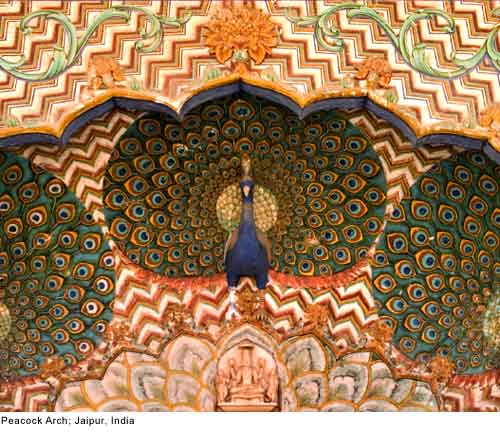
All text is available under the terms
of the GNU Free Documentation License
|